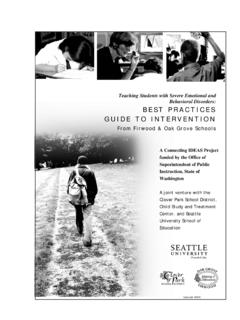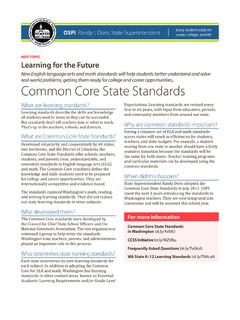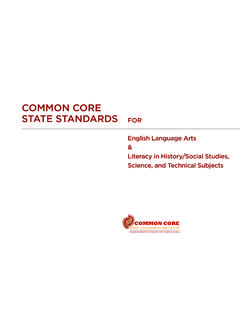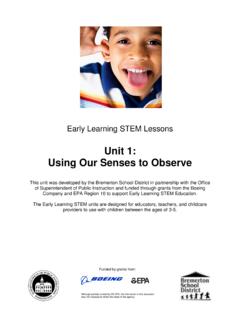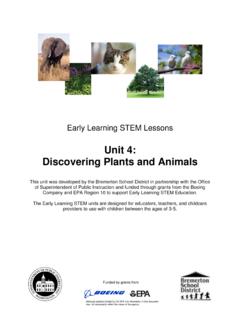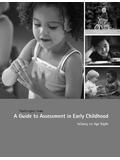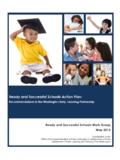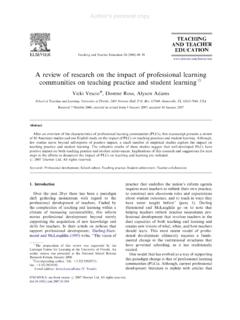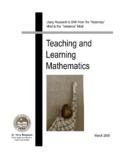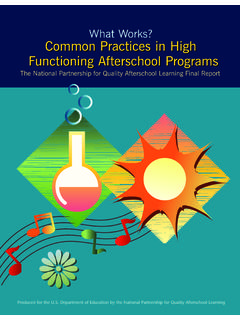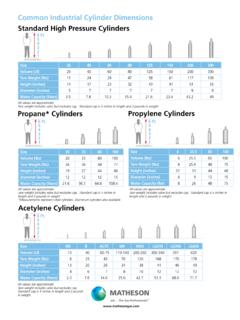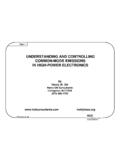Transcription of Second Edition June 2007 - Office of Superintendent of ...
1 Dr. Terry Bergeson Second Edition State Superintendent of Public Instruction June 2007. First Edition : January 2003. ii Office of Superintendent of Public Instruction Old Capitol Building Box 47200. Olympia, WA 98504-7200. For more information about the contents of this document, please contact: Sue Shannon, E-mail: Phone: To order more copies of this document, please call 1-888-59-LEARN (I-888-595-3276). or visit our Web site at Please refer to the document number below for quicker service: 07-0015. This document is available online at: This material is available in alternative format upon request. Contact the Resource Center at (888) 595-3276, TTY (360) 664-3631. Copyright 2007 by the Office of Superintendent of Public Instruction, Olympia, Washington.
2 The contents of this document may be reproduced and distributed for educational purposes without permission. The Office of Superintendent of Public Instruction complies with all federal and state rules and regulations and does not discriminate on the basis of race, color, national origin, sex, disability, age, or marital status. N I N E C H A R AC T E R I S T I C S O F H I G H - P E R F O R M I N G S C H O O L S. iii Nine characteristics of high -Performing Schools Prepared by G. Sue Shannon, Senior Researcher Pete Bylsma, former Director, Research, Assessment, Accountability Assessment and Student Information Office of Superintendent of Public Instruction Dr. Terry Bergeson Superintendent of Public Instruction Dr. Cathy Davidson Chief of Staff June 2007.
3 N I N E C H A R AC T E R I S T I C S O F H I G H - P E R F O R M I N G S C H O O L S. iv Acknowledgements The authors would like to acknowledge the assistance provided by the following people in reviewing earlier drafts of this document and/or providing pertinent information and sources: Chris Barron, Dan Barkley, Kathy Bartlett, Joe Belmonte, Deborah Davis, Sheri Dunster, Cathy Fromme, Deborah Gonzales, Andy Griffin, Debbi Hardy, Janet Hayakawa, Mickey Lahmann, Greg Lobdell, Bill Mason, Shirley McCune, Andrea Meld, Tonya Middling, Robin Munson, Chuck Namit, Janell Newman, PhuongChi Nguyen, Adie Simmons, and school improvement facilitators. In addition we thank Nathan Olson for assistance with design and production. Suggested Citation Shannon, & Bylsma, P.
4 (2007). The Nine characteristics of high -Performing Schools: A research-based resource for schools and districts to assist with improving student learning. (2nd Ed.). Olympia, WA: OSPI. N I N E C H A R AC T E R I S T I C S O F H I G H - P E R F O R M I N G S C H O O L S.. Table of Contents Executive summary.. 1. Introduction.. 3. Nine characteristics of high -performing schools.. 24. Selected resources as starting points.. 25. Expanded definitions, explanations and implementation suggestions 1. Clear and shared focus.. 27. 2. high standards and expectations for all students .. 33. 3. Effective school leadership.. 43. 4. high levels of collaboration and communication .. 54. 5. Curriculum, instruction and assessments aligned with state standards.
5 63. 6. Frequent monitoring of learning and teaching.. 86. 7. Focused professional development.. 96. 8. Supportive learning environment.. 107. 9. high level of family and community involvement.. 119. Summary and conclusions .. 128. Appendix A. Bibliography of research sources for nine characteristics .. 129. Research base summary.. 132. Appendix B. Perception surveys of school characteristics .. 133. Perception survey templates.. 134. N I N E C H A R AC T E R I S T I C S O F H I G H - P E R F O R M I N G S C H O O L S. Executive summary Successful schools do exist. Despite reports of achievement gaps and low test scores, many schools have shown sustained progress in educating children. How are they doing it? And do similarities exist among those schools?
6 In 2002, Washington state school improvement specialists from the Office of Superin- tendent of Public Instruction (OSPI) reviewed more than 20 studies to answer those questions. The studies most of which looked at elementary schools focused on schools with students who achieved at higher levels than their demographic charac- teristics would predict. From the studies, OSPI researchers distilled nine characteristics that were found most often in high -performing schools: 1. A clear and shared focus 2. high standards and expectations for all students 3. Effective school leadership 4. high levels of collaboration and communication 5. Curriculum, instruction and assessments aligned with state standards 6. Frequent monitoring of learning and teaching 7.
7 Focused professional development 8. A supportive learning environment 9. high levels of family and community involvement No single characteristic led to school success. Most studies identified five or more of the traits. Research found that reaching that level takes years of sustained school commitment, affecting values, attitudes, beliefs, and instructional practices. Cursory attention to the nine characteristics will yield superficial changes, but not lasting success. Using these results, OSPI published the first Edition of Nine characteristics of high - Performing Schools in January 2003. N I N E C H A R AC T E R I S T I C S O F H I G H - P E R F O R M I N G S C H O O L S. Executive Summary | . Second Edition Since publication of the first Edition , the characteristics have become a framework for school improvement in Washington.
8 Also, more research has been done on high - performing schools and improving student learning. With that in mind, in 2006 OSPI. asked a number of experts to review the original document. Their comments and suggestions helped shape the Second Edition of Nine characteristics .. In essence, reviewers confirmed the validity of the nine characteristics . They noted that, for continuity, the original characteristics and definitions should remain. But ad- ditional ideas and suggestions for implementation were identified from research and professional literature. These concepts, discussed throughout this document, include: A. Effective processes for improving schools B. Expanded perspectives on effective leadership C. Relational trust ( , trusting relationships among persons in an organization).
9 D. Quality instruction, grading practices, and monitoring E. Professional learning communities F. Cultural competence and culturally responsive teaching G. Family and community engagement in schools H. high school improvement I. District improvement J. Need-based allocation of resources (funding, staffing, and support). Each concept expands and deepens our understanding of the characteristics . Some relate specifically to individual characteristics ; others relate to several characteristics and are discussed in multiple sections. The new concepts suggest additional ideas and avenues for improving schools and learning. For example, the discussion of cur- riculum, instruction, and assessment, in particular, provides more information to help improve learning and teaching.
10 The Second Edition also focuses on how the nine characteristics are interrelated and suggests a continuous cycle of action that systematically attends to all nine. Seminal research on effective schools is included, as well as about 120 new references and rel- evant OSPI documents. The overall purpose of the document is to help schools successfully implement their school improvement efforts to get beyond making plans to taking action. School Improvement Perception surveys included in Appendix B can be used to gather information from staff, students, and communities to help gauge their school im- provement progress. Since the 1993 passage of House Bill 1209, we have learned a great deal about educa- tional reform. Improvements have been made.
